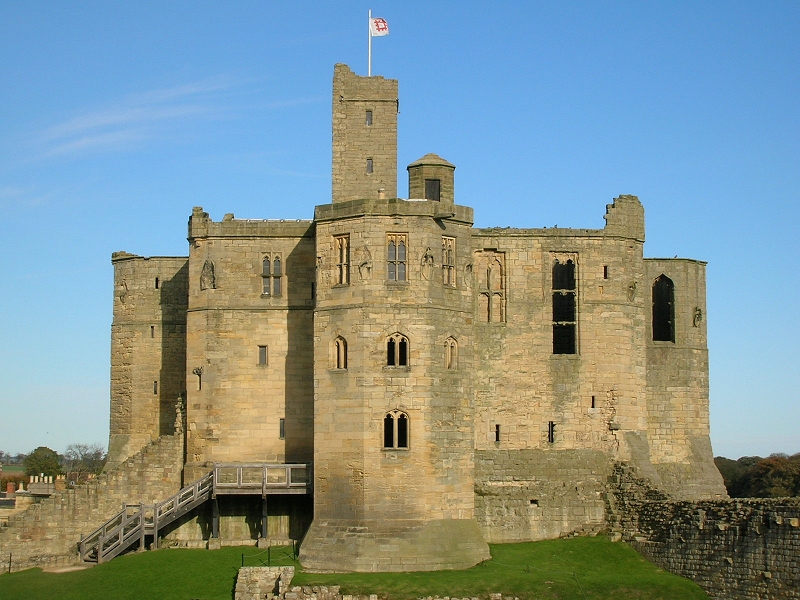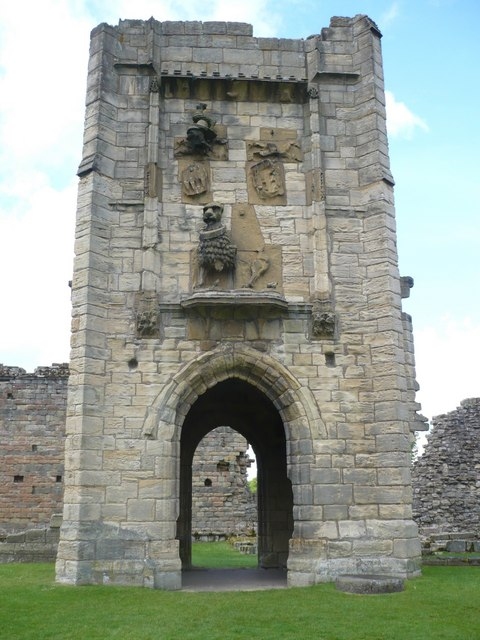
We turn east, heading toward the sea and travel along the A1068 which parallels the shoreline of Alnmouth Bay. High hedgerows along this route frustrate me to no end. I only get an occasional glimpse of golden sand and frothy argentine water. Before long we are pulling into the car park at Warkworth Castle. Gathering Heritage passes and cameras, we set out to explore this exceptionally well maintained castle.
Warkworth is an ancient place, first recorded in the early eighth century. There was no castle here, however, until the mid-twelfth century. Earl Henry of Northumberland, the son of King David I of Scotland, built the earliest fortress, which was probably a motte and bailey castle. At the time, this area was part of Scotland, but in 1157 Henry II recovered Northumberland from the Scots.
Well placed on a stretch of land between a loop in the River Coquet and the North Sea, building work and fortifications went on through the mid-14th century. By 1292 Warkworth was grand enough to accommodate Edward I, who spent a night here.
In 1327 the castle was twice besieged by the Scots. Edward III, perhaps realizing that Warkworth was too far from London for him to be able to defend it properly, granted it to Henry de Percy II. It remained in the hands of the Percy family until 1403 when Henry de Percy IV, the first Earl of Northumberland, turned against Henry IV.
Warkworth was battered into submission by cannons and the earl's estates were declared forfeit. The castle passed back and forth between the Percys and the Crown due to political maneuvering of the Percy family throughout the 15th century. In 1537 the 5th Earl of Northumberland died, leaving all of his possessions to Henry VIII.
We wander around the extensive grounds and buildings of the Outer Bailey, climbing up into the gate house and standing on the drawbridge where we peer down a gap to the ground below. Here, under siege, the portcullis would be dropped and rubbish thrown down on the heads of the attackers. The Percy lion is evident in several places here, including the Lion Tower and in a heraldic carving, where the lion stands rampant, on the north face of the keep.
The keep, built in the late 14th century is most impressive and complete. Like all of the other castles I've explored, nothing is left uninvestigated here. Up and down stairways we climb to visit each and every chamber, the kitchens, chapel, and storage rooms – all of which are intact well maintained.
These Percys must have been great partiers, as they had two wine cellars and a separate beer cellar in close proximity to the Hall. The fireplaces seem large enough for a party themselves, and standing inside, masons marks are visible in several places on the inside of the chimneys. I am most particularly impressed by the lightwell, an ingenious structure which rises several stories above the keep.
Open to the sky above and pierced by windows which admit air and daylight to parts of the keep which would otherwise be dark, the lightwell also served as a funnel for rainwater which was used to flush out the latrine shafts.
I discover a small room off of the Great Hall in my wandering. There are stone ledges here – window seats – and the view is spectacular from these narrow windows. The air is chilly, fresh and briny; I can hear but not spy seagulls. This is a peaceful place, despite the battles that it has witnessed and withstood, a lovely nook that looks out on the green of the Inner Bailey, lit by the summer sun, and the leaves dancing on the trees along the banks of the Coquet.
As I did atop Walltown Crags, I think of returning in the winter, when blustery winds and ominous skies threaten, when breath comes out in misty plumes, when the River is edged with frosty thin ice. And then I think of visiting during a thunderstorm. Oh, how the thunder would rumble around these wide empty chambers and bolts of lightning send streaks of blinding light through the windows and cast an eerie glow across these ancient stone walls.
I forcefully waken myself from my daydream. No, no storms, no rain, I tell myself; we don't want a thunderstorm today. We have many places to see, and it's time to move on.
We're back in the car and continuing south on the A1068. The hedgerows have given way and I spy Coquet Island in the bay, its lighthouse rising high into the sky. The sun sparkles on the water and seagrasses wave in a slight breeze. This drive along the coast is soporific and oh so lovely. I am surprised there aren't people walking these golden beaches and decide that the coast of Northumberland is a well kept secret.
All too soon we are heading west and I bid a fond farewell to the North Sea, not realizing at the time that I will see it once more before I return home.

Warkworth Castle is a ruined medieval building in the village of the same name in the English county of Northumberland. The village and castle occupy a loop of the River Coquet, less than a mile from England's north-east coast.
Warkworth Castle is an irregular enclosure. The keep is at the north end, overlooking the town, with the bailey to the south. The current keep was built on an earlier mound, known as a motte. The curtain wall of the bailey dates from the early 13th century.
The Lion Tower was the entrance to the north end of the great hall. Above the archway through the tower were displayed heraldic items, symbolic of the Percy earls' power. The lion at the bottom was the emblem of the earls. Though now much damaged, above the lion were the ancient arms of the family and the arms of the Lucy family, whose property the Percys had inherited in the 1380s.
Read more about Warkworth Castle.